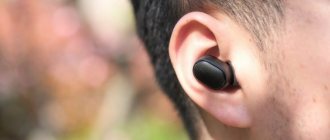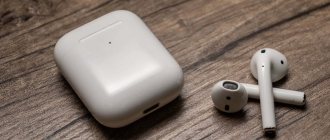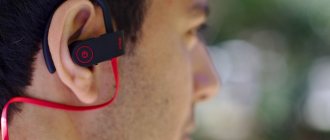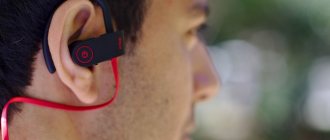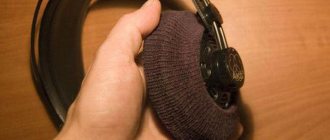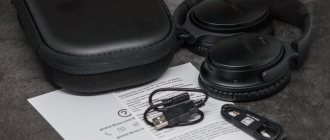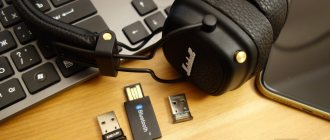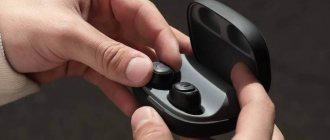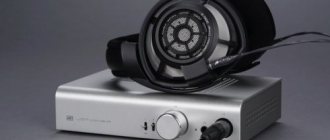4.8 / 5 ( 64 voices)
Despite the wide variety of headphones, they all have a similar construction principle and ear pads are an integral part of them. The quality of this element determines the comfort of using headphones, sound quality, and the degree of noise reduction. about what ear pads are, how to choose them and much more in our article today.
- What are headphone ear pads?
- Types of headphone tips
- Materials of manufacture and influence on sound
- How to choose ear pads?
- How to change tips on headphones?
What are headphone ear pads?
What are ear pads?
The ear pads in headphones are the same tips that come into contact with a person's ear when using an audio device. It is impossible to operate any type of headphones without them. In full-size and on-ear headphones, the ear pads are soft pads that come into contact with the ears and head. If we are talking about earbuds or in-ear headphones, then the ear pads are attachments built into the body of TWS headphones.
The main task of this element is to ensure comfortable use of the audio device. The second functional feature is sound insulation, also known as noise reduction. These functional features manifest themselves differently depending on many factors. We are talking about design features and material of manufacture. The degree of fixation of the element in the auricle also depends on the structural features.
Ear pads are replaceable elements that can be replaced with new ones as they wear out.
Types of headphone tips
Before you figure out how to remove and change ear pads, you need to familiarize yourself with their main types. They differ in shape, size, and materials of manufacture.
For in-ear headphones:
- Standard
- Foam
- Double flanged
- Anchors
- Custom
- Triple flange
For over-ear headphones:
- "Around the ear" or Circum-aural
- Overhead or Supra-aural
Standard
Standard ear pads
The standard type of ear tips is the most common. They are always included with the headphones in the amount of 3 pieces of different sizes. As a rule, this configuration is quite sufficient for the vast majority of users. The characteristic features of standard ear pads are a rigid base and a soft nozzle that stretches over the sound guide tube.
Foam
Foam ear pads
The peculiarity of this type is that soft foam material is used for its manufacture. Foam models are characterized by elasticity and plasticity, which allows them to take on the shape of the ear canal. This type is characterized by excellent noise reduction and a high degree of comfort.
Double flanged
Double-flange nozzles
This type of accessory has 2 special nozzles - petals and Christmas trees, which differ from each other in diameter. They provide good noise reduction, which has a beneficial effect on the sound. Their advantage is that you can use headphones with them even in environments with high noise levels.
With prolonged use, in most cases they cause unpleasant bursting sensations in the ear area.
Anchors
Anchors
Roughly speaking, anchors are not ear pads, they are an auxiliary means for attaching headphones. They are often supplemented with standard headphone configurations. More often than usual, they are used in sports models of headphones, for which good fixation is of great importance.
Custom
Custom tips
Custom tips are made according to individual impressions of the ears. Ready-made tips are made taking into account all the anatomical features of the structure of human ears. This pleasure is not cheap, but high-quality and comfortable listening to music is guaranteed.
Triple flange
Triple flange
This type of ear pads has much in common with double-flange tips. The only difference is the presence of 3 nozzles. It is important to understand that if the size of the nozzle is chosen incorrectly, you will experience severe discomfort when listening to music.
"Around the ear" and over-ear ear pads
Over-ear ear pads
The first type visually represents large rounded cushions that completely cover the ears. Securely pressed against the head.
The second ones are soft overhead pads of smaller sizes in comparison with the previous ones. They only touch the ear.
Ear pads for full-size headphones can have elongated, rectangular and round shapes.
Ideal characteristics
Having made a basic overview of the basic characteristics of monitor headphones, a potential buyer can easily choose the “ears” that best satisfy his needs. The main points that require analysis before directly purchasing a device include its type, type of connection, impedance (resistance), sensitivity, amplitude-frequency response (AFC).
- In appearance, as becomes clear from the previous paragraph, for “home” use it is worth giving preference to an open accessory that combines ease of wearing and high-quality sound, despite the average sound insulation.
- When considering the type of connection, it is important to consider the purpose for which the selected headphones will be used. For example, if there is a need for studio use (home recording studios), it is advisable to choose a wireless option. While “household” use allows the presence of a cable, due to the work with “ears” exclusively in the vicinity of the mating device.
- Monitor headphones used for professional purposes must have a high-quality resistance indicator at the accessory input (impedance), in other words, be high-impedance (more than 100 Ohms), since their use involves interaction with stationary equipment with a high input voltage level. If you plan to use the selected device with smaller portable devices, you should opt for low-impedance ones (from 16 Ohms to 50 Ohms) or additionally purchase special equipment - an amplifier. Optimal impedance ensures loud sound with accurate frequency reproduction.
- Sensitivity, coupled with resistance, is an indicator responsible for the volume of sound in the “ears”. However, in this case, the manufacturer is not faced with the task of providing the product offered to the consumer with high sensitivity. This statement is explained by the presence of special amplifiers used in work in recording studios. For “home conditions” there are also special devices that help recreate maximum volume. Accordingly, it is not recommended to make the considered indicator of monitor headphones a decisive factor.
- When considering the frequency response, it is important to note that when using this type of accessory not for its intended purpose, but, for example, for normal listening to music, the user should expect “measured, sterile” sound without pronounced low or high frequencies. This fact is due to the emphasis placed by the sound engineers who created the track in the studio on midrange frequencies, vocals and instrumental parts in order to “please” the majority of music lovers. The optimal frequency range for monitor headphones is considered to be 20 Hz – 20 kHz, which is the most comfortable sound for the human ear. Numbers below or above the specified segment are not perceived reliably by the human body; accordingly, such characteristics declared by the manufacturer can be considered a marketing ploy to attract “naive” buyers.
Materials of manufacture and influence on sound
More depends on the material used to make tips for wired headphones than might seem at first glance. It is impossible to unequivocally answer the question of which material for ear pads is the best. Each of them has both positive and negative properties.
- Silicone. Silicone ear tips are common, but many do not like silicone and this is due to the following disadvantage - the material does not breathe, the skin in the ears sweats, which causes discomfort. Compared to other analogues, silicone has poor sound insulation. High-quality silicone does not cut off parts of the range, which cannot be said about budget silicone. Many reputable audio system design and manufacturing companies use silicone tips. The main advantages of the material are long service life and easy maintenance.
- Polyurethane is a type of foam ear pad that was first introduced to the public in the 90s. The main advantages of the material are strength combined with elasticity and viscosity. Such attachments completely repeat the anatomical shape of the ear. It is also worth noting that the material “breathes”.
- Acrylic is a perfect option that has no equal. The material is used primarily in the manufacture of custom wireless headphones. Due to its physical properties, acrylic exactly repeats the anatomical shape of the ear. As for sound, acrylic is completely neutral.
- Leather. This is the most classic solution when it comes to making ear tips for headphones with a headband. Used mainly in premium brands. The main advantages of the material are that the skin breathes, therefore, walking with headphones in hot weather will be quite comfortable. Leather, as a material, has a very beneficial effect on sound quality, especially when it comes to the low-frequency range.
- Artificial leather is no less common, as it can significantly reduce the cost of headphones. The texture and appearance of artificial material is difficult to distinguish from genuine leather. Many will be surprised, but high-quality leatherette is also a breathable material. Disadvantages include unpredictability of behavior under significant temperature changes; leatherette can burst and fall off in pieces.
- Velours. In terms of ergonomics, this is the most suitable material. This material is pleasant to touch the skin, and it also has excellent sound-absorbing properties. The disadvantages include low practicality. Compared to leather and faux leather, velor wears out and gets dirty faster.
- Microfiber. Of all existing materials, this is the most breathable. At the same time, its cost is not high; most budget headphones are equipped with it. In terms of sound, the material is neutral and has pleasant tactile qualities. The disadvantages include a short service life.
How to choose ear pads?
How to choose ear pads?
Many connoisseurs of high-quality sound and comfort have a question about how to choose ear pads . When choosing, you should pay attention to the following parameters that determine functionality, practicality and comfort of use:
- When choosing headphones, the greatest importance should be given to the material used to make the ear pads. The material must be hypoallergenic; it is better not to give preference to rubber.
- The size of the tips must match the diameter of the ear canal. To do this, it is enough to try on the probes and analyze your sensations - whether there is a bursting sensation or, on the contrary, whether the embouchure falls out. Sound quality is analyzed in the same way.
- The shape of the tips should also be selected taking into account the individual characteristics of the structure of the ear canal. You can determine the most suitable shape by trying on.
If financial possibilities allow, then, of course, it is best to purchase customized headphones, which will be made taking into account all the individual features of the structure of the human auricle.
Something special
In addition to size and shape, single-circuit ear pads may also differ in design. They usually consist of two parts: a tube that fits onto the sound guide, and a sealing skirt. The space between these two parts, as a rule, is not filled with anything.
However, some manufacturers complicate the design by casting additional jumpers in this space or filling it with special materials. This increases the elasticity of the ear pads, makes the fit tighter, and can improve noise isolation if they are the right size and shape. And of course, there will always be those for whom such ear pads are absolutely not suitable, because they are denser than usual.
The crux of the matter: Silicone ear pads can be anything but simple.
Life hack: Modified ear pads can rarely be found on the open market. As a rule, they are included with expensive headphone models.
